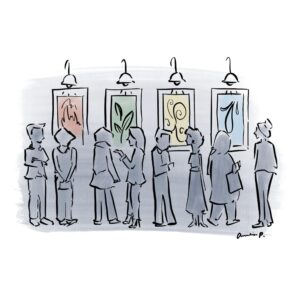Dec 5, 2023
Dec 5, 2023
In his rustic cabin in the forests of southern Finland, 87-year-old Erkki Pekkarinen carves delicate strips of birch bark with his knife, before intricately weaving them into beautiful objects.
“I started practising at the age of 10. You could say that for 77 years I’ve been fiddling with birch bark,” Pekkarinen tells AFP.

While wood is generally perceived as a robust and inflexible material, Pekkarinen insists that, with the right technique, birch bark can be used to make “anything you can imagine”.
His art gallery in Asikkala is filled with a myriad of objects constructed of nothing but strips of birch bark woven together without glue or nails.
When properly processed, the cardboard-like honey-hued bark from the black and white boreal tree can be effortlessly cut and flexed.
Pekkarinen has crafted everything from detailed wooden jewellery and handbags to small toy ducks and backpacks.
His piece de resistance is a full suit, complete with a hat, briefcase and shoes.
It creaks and rustles as he puts it on but it is surprisingly flexible when Pekkarinen walks around the cabin, which is brimming with his wooden artwork
Born in the eastern Finnish town of Lieksa, Pekkarinen says his interest in bark dates back to his youth when he worked as a lumberjack.
“I liked to spend my time at the logging camp crafting all kinds of things. There was plenty of free time back then,” he says.
Stone Age traditions
He recalls birds gnawing through colleagues’ cotton backpacks to steal their lunch while they were felling trees but his own food remained safe in his sturdy bark rucksack.
Full bark suits may have been rare in the Nordic country’s past but the age-old tradition of weaving birch bark into everyday items dates far back.
Tracing its origins to the Stone Age, birch bark has served a role akin to our contemporary use of plastic, from boxes for storing berries to small toys for children.
With its water-resistant and insulating properties, the early inhabitants of the Arctic region traversed snowy forests with bark shoes on their feet and bark packs on their shoulders.
The material was once so valuable that it left its mark on the Finnish language — the expression “to collect bark” still means “to make money”.
Pekkarinen said that with the correct technique, the bark can be removed from the trunk without killing the tree.
“It will still be usable in 10 years,” Pekkarinen says, holding a roll of bark that he has cleaned and dried.
Using a stockpile of bark that he gets from friends and family, Pekkarinen crafts whatever comes into his mind.
“You can make whatever your imagination will allow,” he says, showing off a football-sized bark version of a Covid-19 virus, complete with spikes extending in every direction.
Copyright © 2024 AFP. All rights reserved. All information displayed in this section (dispatches, photographs, logos) are protected by intellectual property rights owned by Agence France-Presse. As a consequence you may not copy, reproduce, modify, transmit, publish, display or in any way commercially exploit any of the contents of this section without the prior written consent of Agence France-Presses.
This post was originally published on this site be sure to check out more of their content


